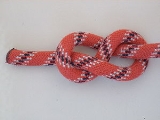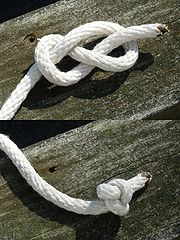
Figure-of-eight knot
Encyclopedia
The figure-eight knot is a type of knot
. It is very important in both sailing
and rock climbing
as a method of stopping ropes from running out of retaining devices. Unlike the overhand knot
, which will bind iron-hard under strain, often requiring the rope to be cut, the figure of eight can be easily untied after even the greatest strain.
knot. This type of knot can be used in prusik climbing when used in conjunction with a climbing harness
, a climbing rope, and locking carabiner
designed for climbing, to ascend or descend with minimal equipment and effort.
" together two ropes, not necessarily of equal diameter. This knot is tied starting with a loose figure eight knot on one rope (the larger-diameter one if unequal), and threading of the other rope's running end through the first figure eight, starting at the first figure-eight's running end and paralleling the path of the first rope through the figure eight until the second's ropes running end lies parallel against first's standing end. The result is two figure-eight knots, each partly inside the other and tightening its hold on the other when they are pulled in opposite directions. This can be a permanent or temporary splice. While it precludes the ropes' slipping relative to each other, it is a typical knot in having less strength than the straight ropes. A blood knot
is a better knot for rope splicing, but is more difficult to achieve.
In heraldry
, this knot is known as Savoy knot
.

or humorously;
 The Stein knot (aka Stone knot) is a variation of the Figure 8 knot. It is used to secure a rope that is already passed around a post or through a ring. It is quick and easy to tie and untie. It is a device rigging rather than a true knot.
The Stein knot (aka Stone knot) is a variation of the Figure 8 knot. It is used to secure a rope that is already passed around a post or through a ring. It is quick and easy to tie and untie. It is a device rigging rather than a true knot.
In canyoneering, it is used to isolate rope strands to allow one person to rappel
while another is getting on the rappel, or allow rappellers the option of using a single or a double rope.
Knot
A knot is a method of fastening or securing linear material such as rope by tying or interweaving. It may consist of a length of one or several segments of rope, string, webbing, twine, strap, or even chain interwoven such that the line can bind to itself or to some other object—the "load"...
. It is very important in both sailing
Sailing
Sailing is the propulsion of a vehicle and the control of its movement with large foils called sails. By changing the rigging, rudder, and sometimes the keel or centre board, a sailor manages the force of the wind on the sails in order to move the boat relative to its surrounding medium and...
and rock climbing
Rock climbing
Rock climbing also lightly called 'The Gravity Game', is a sport in which participants climb up, down or across natural rock formations or artificial rock walls. The goal is to reach the summit of a formation or the endpoint of a pre-defined route without falling...
as a method of stopping ropes from running out of retaining devices. Unlike the overhand knot
Overhand knot
The overhand knot is one of the most fundamental knots and forms the basis of many others including the simple noose, overhand loop, angler's loop, reef knot, fisherman's knot and water knot. The overhand knot is very secure, to the point of jamming badly. It should be used if the knot is...
, which will bind iron-hard under strain, often requiring the rope to be cut, the figure of eight can be easily untied after even the greatest strain.
Double figure-eight knot
Double figure-eight knot (figure-eight loop) is used like an overhand loopOverhand loop
The Overhand loop is a simple knot which forms a fixed loop in a rope. Made by tying an Overhand knot in the bight, it can be tied anywhere along a rope . The knot can be used for attaching clips, hooks, other rope, etc., but has the disadvantage that it is likely to jam tight when the rope has...
knot. This type of knot can be used in prusik climbing when used in conjunction with a climbing harness
Climbing harness
A climbing harness is a piece of equipment used in certain types of rock-climbing, abseiling or other activities requiring the use of ropes to provide access or safety...
, a climbing rope, and locking carabiner
Carabiner
A carabiner or karabiner is a metal loop with a sprung or screwed gate that is used to quickly and reversibly connect components in safety-critical systems. The word comes from "Karabinerhaken", meaning "hook for a carbine" in German.-Use:...
designed for climbing, to ascend or descend with minimal equipment and effort.
Figure-eight splice knot
Figure-eight splice knot is used to quickly and effectively "spliceRope splicing
Rope splicing in ropework is the forming of a semi-permanent joint between two ropes or two parts of the same rope by partly untwisting and then interweaving their strands. Splices can be used to form a stopper at the end of a line, to form a loop or an eye in a rope, or for joining two ropes...
" together two ropes, not necessarily of equal diameter. This knot is tied starting with a loose figure eight knot on one rope (the larger-diameter one if unequal), and threading of the other rope's running end through the first figure eight, starting at the first figure-eight's running end and paralleling the path of the first rope through the figure eight until the second's ropes running end lies parallel against first's standing end. The result is two figure-eight knots, each partly inside the other and tightening its hold on the other when they are pulled in opposite directions. This can be a permanent or temporary splice. While it precludes the ropes' slipping relative to each other, it is a typical knot in having less strength than the straight ropes. A blood knot
Blood knot
A blood knot is most usefully employed for joining sections of monofilament nylon line while maintaining a high portion of the line's inherent strength. Other knots used for this purpose can cause a substantial loss of strength...
is a better knot for rope splicing, but is more difficult to achieve.
In heraldry
Heraldry
Heraldry is the profession, study, or art of creating, granting, and blazoning arms and ruling on questions of rank or protocol, as exercised by an officer of arms. Heraldry comes from Anglo-Norman herald, from the Germanic compound harja-waldaz, "army commander"...
, this knot is known as Savoy knot
Savoy knot
The Savoy knot, a type of decorative knot, is a heraldic knot used primarily in Italian heraldry. It is most notable for its appearance on the heraldic badge of the House of Savoy, where it is accompanied by the motto Stringe ma non costringe, "It tightens, but does not constrain"...
.
Tying

- Make a bightBight (knot)In knot tying, a bight is a curved section, slack part, or loop between the two ends of a rope, string, or yarn. The term is also used in a more specific way when describing Turk's head knots, indicating how many repetitions of braiding are made in the circuit of a given knot.-Slipped knot:In order...
in a rope - Twist it around half a turn away from the working end
- Bring the working end around from below, then through the loop from above
- Pull
or humorously;
- Make an alien (create a loop).
- Choke it (wrap one end around the alien's "neck").
- Poke it in the eye (push the end through the "alien" loop).
Stein knot

In canyoneering, it is used to isolate rope strands to allow one person to rappel
Abseiling
Abseiling , rappelling in American English, is the controlled descent down a rock face using a rope; climbers use this technique when a cliff or slope is too steep and/or dangerous to descend without protection.- Slang terms :...
while another is getting on the rappel, or allow rappellers the option of using a single or a double rope.

